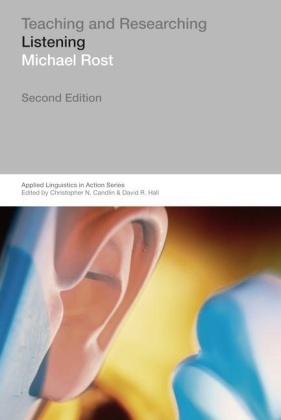Share
Fr. 58.80
Michael Rost
Teaching and Researching: Listening
English · Paperback / Softback
New edition in preparation, currently unavailable
Description
2nd edition. Part of the highly-regarded "Applied Linguistics In Action" series, offering a comprehensive overview of this major area.
List of contents
Contents General Editors' Preface ix Acknowledgements xi Preface xii Introduction: Perspectives on listening Section I Defining listening Introduction: The nature of processing 1 Neurological processing 1.1 Hearing 1.2 Consciousness 1.3 Attention 1.4 Individual differences in neurological processes Summary: Organization of neurological processing 2 Linguistic processing 2.1 Perceiving speech 2.2 Identifying units of spoken language 2.3 Using prosodic features in processing speech 2.4 Recognizing words 2.5 Employing phonotactic knowledge 2.6 Utilizing syntactic parsing 2.7 Integrating non-verbal cues into linguistic processing Summary: Unification of linguistic processing 3 Semantic processing 3.1 Comprehension: The role of knowledge structures 3.2 Cognitive understanding: The role of schemas 3.3 Social understanding: The role of common ground 3.4 The role of inference in constructing meaning 3.5 Listener enrichment of input 3.6 Problem-solving during comprehension 3.7 Reasoning during comprehension 3.8 Compensatory strategies during comprehension 3.9 Memory building during comprehension 3.10 Comprehension and learning Summary: Comprehension and understanding 4 Pragmatic processing 4.1 Listening from a pragmatic perspective 4.2 Inferring speaker intention 4.3 Detecting deception 4.4 Enriching speaker meaning 4.5 Invoking social expectations 4.6 Adjusting affective involvement 4.7 Formulating responses 4.8 Connecting with the speaker Summary: Listening as co-construction of meaning 5 Automatic processing 5.1 Goals of automatic processing 5.2 Linguistic processing 5.1.2 Syntactic processing 5.3 Semantic processing 5.4 Pragmatic processing Summary: Automatic processing and human language processing 6 Listening in language acquisition 6.1 Listening in L1 acquisition: Development of linguistic processing 6.1.1 Lexical acquisition 6.2 Listening in L1 acquisition: Development of semantic processing 6.3 Listening in L1 acquisition: Development of pragmatic processing 6.4 Listening in L2 acquisition: Development of linguistic processing 6.4.1 Syntactic development 6.4.2 Lexical development 6.5 Listening in L2 acquisition: Development of semantic processing 6.6 Listening in L2 acquisition: Development of pragmatic processing Summary: Comparison of L1 and L2 language acquisition Section II Teaching listening Introduction: The role of teaching in learning to listen 7 Approaches to teaching listening 7.1 Contexts for teaching listening 7.2 SLA research and language pedagogy 7.2.1 Affective filter hypothesis 7.2.2 Input hypothesis 7.2.3 Interaction hypothesis 7.2.4 Processability hypothesis 7.2.5 Meta-cognition hypothesis 7.2.6 Sociocultural hypothesis 7.3 Development of listening instruction Summary: A balanced approach for teaching listening 8 Input and interaction 8.1 Relevance 8.2 Genres 8.2.1 Narrative 8.2.2 Descriptive 8.3 Authenticity 8.4 Vocabulary 8.5 Difficulty 8.6 Simplification 8.7 Restructuring 8.8 Interaction 8.9 Strategies Summary: Quantity and quality in input and interaction 9 Instructional design 9.1 Structuring learning sequences 9.2 Intensive listening 9.3 Selective listening 9.4 Interactive listening 9.5 Extensive listening 9.6 Responsive listening 9.7 Autonomous listening Summary: Fresh instructional design 10 Listening assessment 10.1 Defining the social and educational context for assessment 10.2 Developing criteria and constructs 10.3 Formulating a model of listening for assessment 10.4 Creating forms of assessment 10.5 Adjusting factors that influence test performance 10.6 Modeling listener processes during assessment 10.7 Assessing listening proficiency in oral interview tests 10.8 Describing listening proficiency Summary: Fairness in assessment Section III Researching listening Section introduction: Direct insight 11 Sociolinguistic orientations 11.1 Listener perspective 11.2 Listener participation 11.3 Listener response 11.4 Listeners in cross-cultural interactions Summary: The social dimension of language 12 Psycholinguistic orientations 12.1 Listener processing 12.2 Listener memory 12.3 Listener misunderstandings 12.4 Listener strategies Summary: Access to psycholinguistic processes 13 Developmental orientations 13.1 Academic listening 13.2 Listening materials 13.3 Autonomous listening 13.4 Teacher training Summary: Mixed methods of research Section IV Exploring listening 14 Resources for further exploration 14.1 Resources for teaching listening 14.1.1 Published sources 14.1.2 Internet sources 14.1.3 Online listening courses 14.1.4 Directories 14.2 Resources for researching listening 14.2.1 Research networks 14.2.2 Research tools 14.2.3 Research sources and avenues for dissemination Summary: Exploring, researching, teaching Glossary References Index
About the author
Michael Rost is author of a number of influential books and articles in the field of oral language development and curriculum design, beginning with the classic Listening in Language Learning (1990). He is also an award-winning author and series editor of several successful language materials series and online courses. As a teacher, teacher trainer, language program director and educational consultant, he has worked with the Peace Corps in West Africa and the Save the Children Foundation in Southeast Asia.
Product details
| Authors | Michael Rost |
| Publisher | Taylor & Francis Ltd. |
| Languages | English |
| Product format | Paperback / Softback |
| Released | 26.01.2011 |
| EAN | 9781408205075 |
| ISBN | 978-1-4082-0507-5 |
| No. of pages | 424 |
| Subject |
Humanities, art, music
> Education
> School education, didactics, methodology
|
Customer reviews
No reviews have been written for this item yet. Write the first review and be helpful to other users when they decide on a purchase.
Write a review
Thumbs up or thumbs down? Write your own review.

